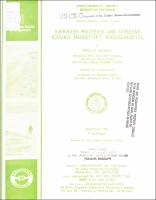Please use this identifier to cite or link to this item:
https://hdl.handle.net/11681/22366Full metadata record
| DC Field | Value | Language |
|---|---|---|
| dc.contributor.author | Zaremba, Robert E. | - |
| dc.contributor.author | Leatherman, Stephen P. | - |
| dc.date.accessioned | 2017-05-09T18:54:30Z | - |
| dc.date.available | 2017-05-09T18:54:30Z | - |
| dc.date.issued | 1984-12 | - |
| dc.identifier.uri | http://hdl.handle.net/11681/22366 | - |
| dc.description.abstract | Abstract: Many US east coast barrier beaches are retreating landward with sea level rise. This study provides quantitative information on the natural dynamics of barrier beaches along the North Atlantic coast. A geobotanical approach was utilized, which involved a detailed investigation of the physical transport processes, particularly overwash, and the vegetative response. A range of information was collected during different time frames, including short-term field measurements of overwash surges and vegetative quadrat data, historical analysis of the development of plant communities and morphological features, and a geologic evaluation of barrier evolution. These comprehensive baseline data on the natural dynamics of a northeast barrier beach can be used to delineate adverse effects of artificial stabilization, particularly dunebuilding activities. All sections of the Nauset Spit system are subject to dramatic changes either by inlet activity or overwash. Each section along the barrier is eventually affected by these physical transport processes over the long term, culminating in landward barrier migration. Artificial creation and maintenance of dunes and salt marshes can be used to extend various periods of the migration cycle but will not alter the basic biogeological process. Without human intervention, new dunes and salt marshes will eventually become established along the barrier within the correct elevational ranges. However, there can be a considerable time lag due to the opportunistic conditions necessary for recolonization of barren washovers. Dune-building programs can effectively shorten the time necessary for revegetation and stabilization of the barrier landform. By working in association with natural processes, segments of the migrational cycle can be expanded but ultimately not restricted. | en_US |
| dc.description.sponsorship | Environmental Impact Research Program (U.S.) Massachusetts Audubon Society. University of Massachusetts (Amherst campus) | en_US |
| dc.language.iso | en | en_US |
| dc.publisher | Environmental Laboratory (U.S.) | en_US |
| dc.relation.ispartofseries | Miscellaneous Paper;EL-84-8 | - |
| dc.subject | Coast changes--Massachusetts--Nauset Spit | en_US |
| dc.subject | Coastal ecology | en_US |
| dc.subject | Sand dunes--Massachusetts | en_US |
| dc.subject | Marsh plants | en_US |
| dc.title | Overwash processes and foredune ecology, Nauset Spit, Massachusetts | en_US |
| dc.type | Report | en_US |
| Appears in Collections: | Miscellaneous Paper | |
Files in This Item:
| File | Description | Size | Format | |
|---|---|---|---|---|
| MP EL-84-8.pdf | 22.61 MB | Adobe PDF |  View/Open |